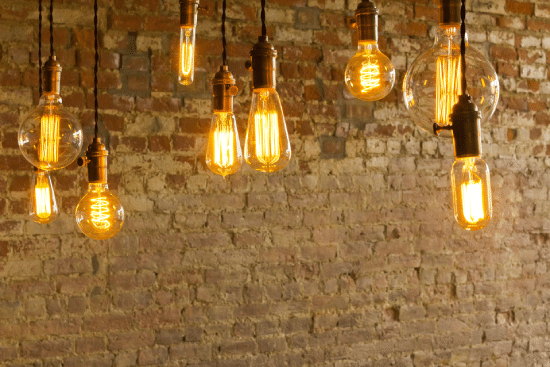Shining Some Light on the Best Energy-Efficient Light Bulbs

If you haven’t already made the switch to energy-efficient lighting from incandescent bulbs, you’re missing out on savings every month. Even if it’s only a few pennies each billing cycle, it can really add up. Light bulbs now also last for years instead of months and offer flexible lighting solutions that are both energy-efficient and cost-effective.
Brennan Electric offers residential and commercial electrical services throughout Seattle and the Puget Sound area, and we’re here to help you with all of your home lighting needs. Here’s some of the basic information you need to get started creating energy-efficient lighting solutions in your home. Whether you’re building a new home, remodeling an existing home, or simply looking to tighten your belt on your energy usage, energy-efficient light bulbs offer a lot of great options.
New Terminology
Most of us use wattage to describe the brightness of light bulbs, but it’s not actually a measure of light intensity or brightness. Wattage is a measure of the amount of energy required to power the bulb, and the brightness of a bulb is measured in lumens. Both numbers have always been printed on the light bulb packaging, but we’ve grown so accustomed to using wattage to describe a light bulb’s brightness that new light bulbs continue to indicate the equivalent amount of lighting using the same terms. For example, a 10-watt LED bulb and a 60-watt incandescent light bulb both emit around 800 Lumens. We’ll probably still colloquially use the term “60-watt light bulb” for the foreseeable future, even though the actual wattage used to provide the same amount of lumens will be a fraction of the original number.
There are a couple of other new terms you’ll also need to learn as well. The Color Rendering Index (CRI) number ranges from 0 to 100, and a higher number will mean truer colors. You choose your paint colors and decor colors for a reason, and you’ll want to purchase bulbs with a CRI of at least 80 for your home in order to accurately represent your color choices. You’ll also need to learn about color temperature, which is reflected in terms of a Kelvin (K) number. As the Kelvin number increases, the light temperature will be cooler. We’ll be discussing light temperature in more detail shortly.
Types of Light Bulbs
One of the first types of energy-efficient light bulbs to hit the market was the Compact Fluorescent Lamp (CFL) style bulb. Fluorescent lighting provides a higher amount of lumens using about 75% less energy than a standard incandescent bulb. Fluorescent light fixtures have long been a common sight in schools, government office buildings, and other commercial properties, but they weren’t always very practical for many common household uses. The CFL bulb enabled homeowners to install fluorescent bulbs into conventional light sockets for energy savings. CFL bulbs have the same limitations as fluorescent tubes, and the lighting can often be harsher and show color more poorly. They also don’t work very well with dimmers, photocells, and motion sensors. Fluorescent tubes have always contained trace amounts of mercury, and CFL bulbs are no different. Even the most well-behaved children knock over lamps frequently, so LED bulbs are a much safer alternative.
Halogen light bulbs use about 25 percent less energy than a conventional incandescent bulb, and you can expect bright light instantly. Halogens are very popular for automotive headlights, and they make great household lighting in key locations because of their dimmability. They also have very good color rendering compared to incandescent or CFL bulbs. The tradeoff is that they usually require gloves to install and have to be replaced every year or two.
Light-Emitting Diode (LED) lighting has become very popular as an everyday option in recent years. An LED light bulb uses slightly less energy than a CFL bulb and doesn’t have many of the same limitations. Some LED bulbs are dimmable, and many work fine with photocells and timers. They are often heavier than standard light bulbs, and some don’t cast light in every direction, but the big advantage of making the move to LED lighting is that the bulbs almost never need to be replaced. In fact, some manufacturers are even claiming that their bulbs will work for over 40 years. LED bulbs also emit almost no heat and are completely safe for use around children and pets.
Household Lighting Design Ideas
Color temperature is a very important component of lighting design, and it gives you a lot of flexibility in the home. A higher Kelvin number means cooler light. You need to assess the functionality of each light in the home and strike the right balance between task lighting and ambient lighting.
Bathrooms are generally better served with cooler lighting or lighting with a number of 3000K or higher. You can expect your brightest whites at around 4000-4100K and bluer whites at 5000K and higher. Cooler light temperatures can distort colors, so you might want to use halogen bulbs or warmer bulbs for your vanity or makeup mirror. Be sure that all of your fixtures are approved for use in bathrooms and that your bathroom outlets are Ground Fault Circuit Interrupter (GFCI) outlets for safety. Warm lighting works best for bedrooms and living rooms, so you should consider shopping for bulbs in the 2700 to 2900 Kelvin (K) range.
If you’re on a budget, you don’t have to phase out all of your light bulbs immediately. If you have an incandescent reading lamp that you really enjoy, continue to use it until you can no longer find bulbs. That time might be coming sooner than you think. If you’re replacing a few bulbs at a time in a vanity or a row of track lights, make sure that the new bulbs have the same color temperature or K number as the existing bulbs.
You should replace the most frequently used bulbs in main areas first to see how you like them. Buy just one or two bulbs at first, and be sure to experiment. In fact, it might be to your advantage to take your time, because the technology continues to improve and prices are continuing to come down.
Outdoor floodlights or spotlights are a great way to add an additional layer of security to our home. If you purchase bulbs in the 2700 to 3000 Kelvin range, your warm-colored exterior paints will really pop at night. On the other hand, if you have a traditional Colonial style home, then 3500K or higher floodlights will really bring out your greys and earth tones and make your white paint gleam after dark. CFLs will take longer to fully illuminate than LEDs or Halogen lights and aren’t ideal to use outdoors in a colder climate. LED lighting isn’t affected by cold temperatures and offers greater energy efficiency than CFL lighting. Be sure that whatever bulbs you purchase will work with your motion sensor or photocell lighting.
Brennan Electric offers residential and commercial electrical services throughout Seattle and the Puget Sound Area, and we can also install carbon monoxide detectors and emergency generators. Contact us today for more information or to schedule an energy efficiency evaluation!

